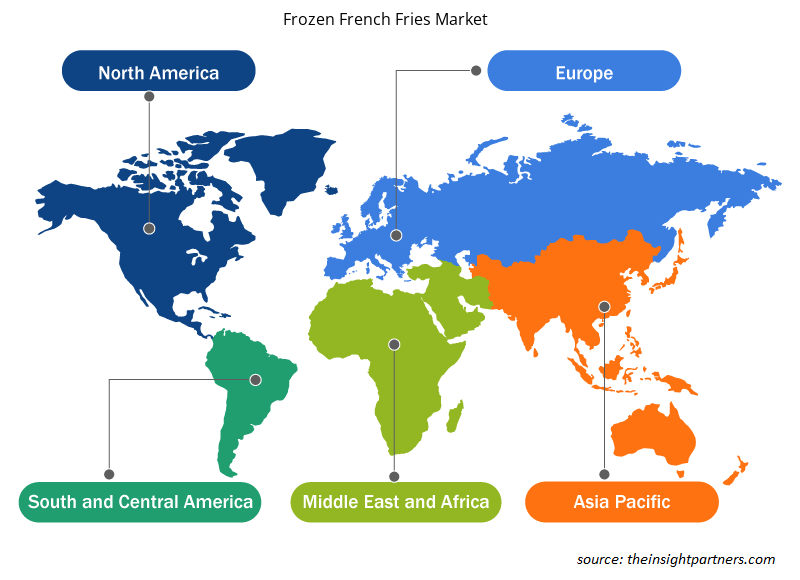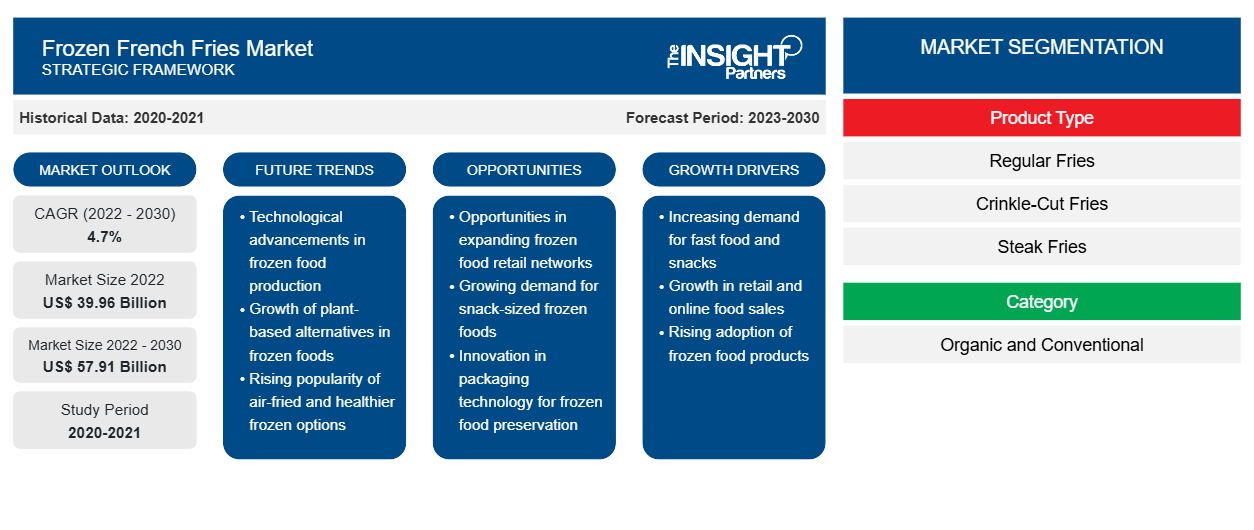[Forschungsbericht] Der Markt für tiefgefrorene Pommes frites soll von 39.955,11 Millionen US-Dollar im Jahr 2022 auf 57.910,15 Millionen US-Dollar im Jahr 2030 wachsen; von 2022 bis 2030 wird eine durchschnittliche jährliche Wachstumsrate (CAGR) von 4,7 % erwartet.
Markteinblicke und Analystenansichten:
Tiefkühl-Pommes Frites werden aus Kartoffeln hergestellt und heiß serviert. Pommes Frites können in verschiedenen Formen hergestellt und serviert werden, beispielsweise als Waffeln, in Locken oder in dünnen Streifen, und werden als praktischer Snack gegessen. Sie werden mit Ketchup, Salsa und anderen Zutaten serviert. Pommes Frites können gebacken oder frittiert werden. Darüber hinaus helfen frische, unverwechselbare Gewürze und Aromen den Pommes Frites, sich von der Konkurrenz abzuheben und Kunden anzuziehen, die nach unerforschten kulinarischen Erlebnissen suchen. Das Geschmacksprofil von Pommes Frites kann durch Experimente mit verschiedenen Kräutern, Gewürzen und Würzmischungen verbessert werden, wodurch die Auswahl an verfügbaren Alternativen erweitert wird, um eine größere Vielfalt an Verbraucherwünschen zu befriedigen. Das Wachstum des globalen Marktes für Tiefkühl-Pommes Frites ist auf die steigende Zahl von Unternehmen zurückzuführen, die Online-Lieferdienste für Lebensmittel anbieten, darunter Food Panda, Swiggy, Uber Eats und andere. Sie haben das Bestellen von Lebensmitteln für Verbraucher zu einer einfachen und praktischen Aufgabe gemacht. Darüber hinaus wird erwartet, dass die zunehmende Produkteinführung wichtiger Branchenteilnehmer den Markt für Tiefkühl-Pommes Frites im Prognosezeitraum vorantreiben wird.
Wachstumstreiber und Herausforderungen:
Die Kühlkette, die aus Vorkühlung, Kühllagerung und Kühltransport besteht, ist eine der Säulen der Nachernte-Handhabungskette. Sie gilt als das Rückgrat jeder Nachernteindustrie (entwickelt oder in der Entwicklung) und als unverzichtbare Technologie zur Reduzierung von Lebensmittelverlusten. Die Kühlkettenlogistik hat sich für jedes Land, das seinen Marktanteil bei Tiefkühlkost steigern möchte, als entscheidend erwiesen . Die Kühlketteninfrastruktur hat in den letzten Jahren deutlich zugenommen. Laut dem Bericht des International Institute of Refrigeration (IIR) und der Global Cold Chain Alliance (GCCA) beispielsweise stieg die Gesamtkapazität der Kühlhäuser weltweit im Jahr 2020 auf 719 Millionen Kubikmeter, 16,7 % mehr als die im Jahr 2018 gemeldete Kapazität.
Darüber hinaus ist der Ausbau der Kühlkettenkapazität in Schwellenländern von Land zu Land unterschiedlich. In den meisten Ländern, wie Südafrika, Mexiko und Kenia, konzentriert sich die Kühlkette auf städtische Gebiete und Transportterminals wie Flughäfen, wo Exporteure angesiedelt sein können. Darüber hinaus verbessern die großen Marktdienstleister ihre Technologien ständig, um der Konkurrenz einen Schritt voraus zu sein und weltweit Effizienz, Integrität und Sicherheit aufrechtzuerhalten. Beispielsweise haben Anbieter Hazard Analysis and Critical Control Points (HACCP) und Radio Frequency Identification (RFID)-Technologie implementiert, um die Effizienz bei kleineren Sendungen zu verbessern. Darüber hinaus erweitern sie ihre Flotten von Kühlfahrzeugen mit mehreren Abteilen, um den Verbrauchern zusätzliche Dienstleistungen anzubieten. Daher wird erwartet, dass Fortschritte in der Kühlketteninfrastruktur den Akteuren auf dem Markt für Tiefkühlpommes Frites lukrative Möglichkeiten bieten und das Wachstum des Marktes für Tiefkühlpommes Frites weiter vorantreiben.
Passen Sie diesen Bericht Ihren Anforderungen an
Sie erhalten kostenlos individuelle Anpassungen an jedem Bericht, einschließlich Teilen dieses Berichts oder einer Analyse auf Länderebene, eines Excel-Datenpakets sowie tolle Angebote und Rabatte für Start-ups und Universitäten.
- Holen Sie sich die wichtigsten Markttrends aus diesem Bericht.Dieses KOSTENLOSE Beispiel umfasst eine Datenanalyse von Markttrends bis hin zu Schätzungen und Prognosen.
Berichtssegmentierung und -umfang:
Der „globale Markt für tiefgekühlte Pommes Frites“ ist nach Produkttyp, Kategorie, Endverbraucher und Geografie segmentiert. Basierend auf dem Produkttyp ist der Markt in normale Pommes Frites, Wellenschnitt-Pommes Frites, Steak-Pommes Frites und andere unterteilt. Basierend auf der Kategorie ist der Markt in Bio und konventionell unterteilt. Basierend auf dem Endverbraucher ist der Markt für tiefgekühlte Pommes Frites in Einzelhandel und Gastronomie segmentiert. Basierend auf der Geografie ist der Markt für tiefgekühlte Pommes Frites in Nordamerika (USA, Kanada und Mexiko), Europa (Deutschland, Frankreich, Italien, Großbritannien, Russland und der Rest von Europa), Asien-Pazifik (Australien, China, Japan, Indien, Südkorea und der Rest von Asien-Pazifik), den Nahen Osten und Afrika (Südafrika, Saudi-Arabien, die Vereinigten Arabischen Emirate und der Rest von Nahem Osten und Afrika) und Süd- und Mittelamerika (Brasilien, Argentinien und der Rest von Süd- und Mittelamerika) segmentiert.
Segmentanalyse:
Basierend auf dem Produkttyp ist der Markt für Tiefkühlpommes in normale Pommes frites, Crinkle-Cut-Pommes frites, Steak-Pommes frites und andere unterteilt. Das Segment der normalen Pommes frites hatte 2022 den größten Anteil am Markt für Tiefkühlpommes frites und wird im Prognosezeitraum voraussichtlich eine signifikante Wachstumsrate verzeichnen. Normale Pommes frites auf dem Markt für Tiefkühlpommes frites sind eine beliebte Beilage in Fast-Food-Restaurants, Burger-Läden und zu Hause. Normale Pommes frites sind dünner als Steak-Pommes frites und werden normalerweise in Stücke mit einer Dicke zwischen 1/8 und 1/4 Zoll geschnitten. Sie sind oft gesalzen und können mit Ketchup, Essig, Mayonnaise, Tomatensauce oder anderen lokalen Spezialitäten serviert werden.
Regionale Analyse:
Geografisch ist der Markt für Tiefkühlpommes frites in fünf Hauptregionen unterteilt: Nordamerika, Europa, Asien-Pazifik, Süd- und Mittelamerika sowie Naher Osten und Afrika. Der globale Markt für Tiefkühlpommes frites wurde von Nordamerika dominiert und wurde im Jahr 2022 auf rund 35.000 Millionen US-Dollar geschätzt. Europa ist ein zweiter großer Marktteilnehmer mit einem Marktanteil von über 25 %. Der nordamerikanische Markt für Tiefkühlpommes frites ist in die USA, Kanada und Mexiko unterteilt. Der nordamerikanische Markt für Tiefkühlpommes frites ist in die USA, Kanada und Mexiko unterteilt. Die Region ist einer der wichtigsten Märkte für Tiefkühlpommes frites aufgrund der gut etablierten Lebensmittelverarbeitungsindustrie und des steigenden Trends zum Mitnehmen, Essen im Restaurant und zum Verzehr unterwegs. Viele bedeutende Hersteller von Tiefkühlpommes frites wie HJ Heinz Company, JR Simplot Company und McCain Foods Limited sind in der Region aktiv. Diese Unternehmen haben ihr Geschäft in der gesamten Region ausgeweitet und verfügen über erhebliche Marktanteile. Sie verfügen über ein ausgedehntes Vertriebsnetz in der Region, das ihnen hilft, viele Kunden zu bedienen. Alle oben genannten Faktoren treiben also das Wachstum des Marktes für tiefgefrorene Pommes Frites voran.
Branchenentwicklungen und zukünftige Chancen:
Nachfolgend sind verschiedene Initiativen der wichtigsten Akteure auf dem Markt für tiefgekühlte Pommes Frites aufgeführt:
- Im September 2020 erwarb Aviko BV vom Konsumgütergiganten Unilever eine Kartoffelfabrik in Deutschland. Diese Fabrik verarbeitet Kartoffeln zu Markenprodukten wie Kartoffelpüree, Knödeln, Gnocchi und Instant-Snacks.
- Im Oktober 2022 gab Lamb Weston Holdings, Inc. bekannt, dass es eine Vereinbarung zum Kauf der verbleibenden Anteile an seinem europäischen Joint Venture Meijer Frozen Foods BV für 763,58 Millionen US-Dollar abgeschlossen hat.
- Im Juli 2021 modernisierte Lamb Weston seine Pommes-frites-Fabrik in Idaho mit einer Investition von 415 Millionen US-Dollar. Mit dieser Verarbeitungslinie kann die Pommes-frites-Fabrik in Idaho jährlich mehr als 350 Millionen Pfund tiefgefrorene Pommes frites und andere Kartoffelprodukte produzieren.
- Im März 2023 kündigte McCain eine erhebliche Investition in Coaldale an, wodurch sich die Größe seiner Anlage und Produktion in Coaldale, Alberta, verdoppeln wird. Die Investition wird McCains starkes Geschäftswachstum widerspiegeln.
Regionale Einblicke in den Markt für tiefgefrorene Pommes Frites
Die regionalen Trends und Faktoren, die den Markt für Tiefkühlpommes Frites im Prognosezeitraum beeinflussen, wurden von den Analysten von Insight Partners ausführlich erläutert. In diesem Abschnitt werden auch die Marktsegmente und die Geografie für Tiefkühlpommes Frites in Nordamerika, Europa, im asiatisch-pazifischen Raum, im Nahen Osten und Afrika sowie in Süd- und Mittelamerika erörtert.

- Erhalten Sie regionale Daten zum Markt für tiefgefrorene Pommes Frites
Umfang des Marktberichts zu gefrorenen Pommes Frites
| Berichtsattribut | Details |
|---|---|
| Marktgröße im Jahr 2022 | 39,96 Milliarden US-Dollar |
| Marktgröße bis 2030 | 57,91 Milliarden US-Dollar |
| Globale CAGR (2022 - 2030) | 4,7 % |
| Historische Daten | 2020-2021 |
| Prognosezeitraum | 2023–2030 |
| Abgedeckte Segmente | Nach Produkttyp
|
| Abgedeckte Regionen und Länder | Nordamerika
|
| Marktführer und wichtige Unternehmensprofile |
|
Marktteilnehmerdichte für tiefgekühlte Pommes Frites: Auswirkungen auf die Geschäftsdynamik verstehen
Der Markt für tiefgekühlte Pommes Frites wächst rasant, angetrieben von der steigenden Nachfrage der Endverbraucher aufgrund von Faktoren wie sich entwickelnden Verbraucherpräferenzen, technologischen Fortschritten und einem größeren Bewusstsein für die Vorteile des Produkts. Mit steigender Nachfrage erweitern Unternehmen ihr Angebot, entwickeln Innovationen, um die Bedürfnisse der Verbraucher zu erfüllen, und nutzen neue Trends, was das Marktwachstum weiter ankurbelt.
Die Marktteilnehmerdichte bezieht sich auf die Verteilung der Firmen oder Unternehmen, die in einem bestimmten Markt oder einer bestimmten Branche tätig sind. Sie gibt an, wie viele Wettbewerber (Marktteilnehmer) in einem bestimmten Marktraum im Verhältnis zu seiner Größe oder seinem gesamten Marktwert präsent sind.
Die wichtigsten auf dem Markt für tiefgefrorene Pommes Frites tätigen Unternehmen sind:
- Barts Kartoffelfirma
- Aviko BV
- Agristo NV.
- Lamb Weston Holdings Inc.
- McCain
Haftungsausschluss : Die oben aufgeführten Unternehmen sind nicht in einer bestimmten Reihenfolge aufgeführt.

- Überblick über die wichtigsten Akteure auf dem Markt für tiefgekühlte Pommes Frites
Auswirkungen von COVID-19:
Die COVID-19-Pandemie hatte Auswirkungen auf die Wirtschaft und die Industrie in zahlreichen Ländern. Lockdowns, Reiseverbote und Betriebsschließungen in führenden Ländern in Nordamerika, Europa, Asien-Pazifik (APAC), Süd- und Mittelamerika (SAM) sowie dem Nahen Osten und Afrika (MEA) wirkten sich negativ auf das Wachstum verschiedener Industrien aus, darunter auch der Lebensmittel- und Getränkeindustrie. Die Schließung von Produktionsstätten störte globale Lieferketten, Fertigungsaktivitäten, Lieferpläne und den Verkauf verschiedener lebensnotwendiger und nicht lebensnotwendiger Produkte. Verschiedene Unternehmen kündigten mögliche Verzögerungen bei Produktlieferungen und einen Einbruch der zukünftigen Verkäufe ihrer Produkte im Jahr 2020 an. Darüber hinaus zwangen die von verschiedenen Regierungen in Europa, Asien und Nordamerika verhängten Verbote für internationale Reisen die Unternehmen, ihre Pläne für Zusammenarbeit und Partnerschaften vorübergehend auf Eis zu legen.
Wettbewerbslandschaft und Schlüsselunternehmen:
Bart's Potato Company, Aviko BV, Agristo NV., Lamb Weston Holdings Inc, McCain, Farm Frites International BV, Rairandev Golden Fries Pty Ltd, Himalaya Food International Ltd, JR Simplot Company und The Kraft Heinz Co gehören zu den führenden Akteuren auf dem globalen Markt für Tiefkühl-Pommes Frites. Diese Hersteller von Tiefkühl-Pommes Frites bieten hochmoderne Snackoptionen mit innovativen Formen, um den Verbrauchern ein hervorragendes Erlebnis zu bieten.
- Historische Analyse (2 Jahre), Basisjahr, Prognose (7 Jahre) mit CAGR
- PEST- und SWOT-Analyse
- Marktgröße Wert/Volumen – Global, Regional, Land
- Branchen- und Wettbewerbslandschaft
- Excel-Datensatz
Aktuelle Berichte
Verwandte Berichte
Erfahrungsberichte
Grund zum Kauf
- Fundierte Entscheidungsfindung
- Marktdynamik verstehen
- Wettbewerbsanalyse
- Kundeneinblicke
- Marktprognosen
- Risikominimierung
- Strategische Planung
- Investitionsbegründung
- Identifizierung neuer Märkte
- Verbesserung von Marketingstrategien
- Steigerung der Betriebseffizienz
- Anpassung an regulatorische Trends





















 Kostenlose Probe anfordern für - Markt für tiefgekühlte Pommes Frites
Kostenlose Probe anfordern für - Markt für tiefgekühlte Pommes Frites